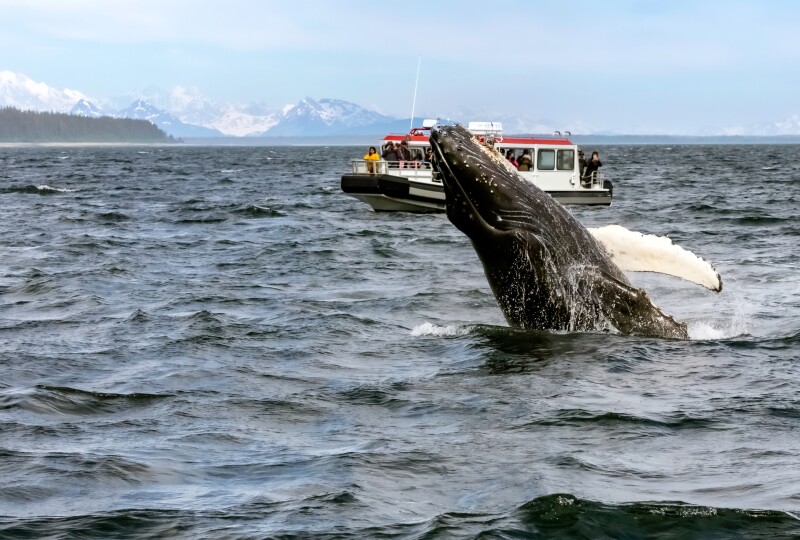It was May 2004, and the Alaska Native–owned Huna Totem Corporation (HTC) was about to welcome its first cruise ship to Icy Strait Point, a new cruise destination not yet on any maps, located just outside the small Tlingit community of Hoonah on Chichagof Island, about 35 miles west of Juneau.
Converting a 100-year-old cannery into a tender port had been a multiyear project, designed to provide locals with jobs and the small city with income. The idea for a port came from enviously watching ships sail by to nearby Glacier Bay, says Johan Dybdahl, 77, who was raised in Hoonah and is now director of special projects for HTC.
As Dybdahl remembers, on the port’s first day, about 60 locally hired employees had stayed up the previous night readying for visitors from the 1,900-passenger Celebrity Mercury.
“When the ship poked its nose around the point, some people started whooping and hollering, and others were crying, and then the ship went right by us and anchored in Hoonah,” Dybdahl laughs, adding that the ship had to be transferred back to the small port.
No one makes that mistake today. What started with 32 ship visits by Royal Caribbean and its Celebrity Cruises brand in 2004 is now some 240 ships representing all the major cruise lines and bringing more than a half million cruise passengers a year to Icy Strait Point.
The port is the largest employer in Hoonah, which has a population of about 920. Additional workers are brought in for the April to October cruise season (roles for the local workers include everything from tour guides to bartenders). During the off-season, the cruise port facility shuts down.

While in port, passengers can ride the recently unveiled electric gondola SkyGlider up the mountain for views of the Juneau Icefield and Glacier Bay.
Courtesy of Huna Totem Corporation
Attractions at Icy Strait Point have grown in scope and scale over the past two decades. In 2007, the port opened the largest ZipRider in the world, a thrill ride on Mount Hoonah with six parallel lines that drop riders down more than 1,300 feet at 60 mph (from $199 per person). A multimillion-dollar, high-speed electric gondola up the mountain debuted in 2021, providing guests views of the Juneau Icefield and Glacier Bay on a clear day (for $50 per person). Another free half-mile gondola ride transports passengers from Wilderness Landing, the farthest of two cruise ship docks across the property, to Ocean Landing, a short walk from the cannery.
Within port are restaurants such as the Crab House serving a Crabby Bloody Mary, containing an appetizer portion of crab, and the Historic Cookhouse, where, within the space where cannery workers once ate, visitors now indulge in fish and chips made from Alaskan halibut, and Alaska reindeer burgers.
Alaskan-owned shops occupy former fish lockers in the wooden cannery building and sell everything from plastic crab magnets to cans of salmon. The Dei L’e.aan shop specializes in Native-made jewelry, wood carvings such as masks, and traditional herbal remedies such as a salve made from the forest plant Devil’s Club that’s used for joint pain.

The former cannery now houses a museum, restaurant, and shops.
EWY Media/Shutterstock
In the historic cannery building, visitors should spend some time at the museum. Exhibits focus on the history of the canning industry in Hoonah, which once produced more than 2 million cans of salmon a year. The first cannery opened in 1912, employing Native fishermen and women, who were involved in the canning process. The industry closed here in 1953. Logging took over as a major employment source for a time, but by the late 1990s it was clear other revenue streams were needed, and cruise tourism became the goal.
Among the more than 20 shore excursions available to cruise ship passengers at Icy Strait Point are whale-watching tours that guarantee sightings, mostly of humpbacks, and bear searches, with the island boasting the highest population of brown bears (per square mile) than anywhere else in the world. More active experiences include outings by kayak and 4x4 tours.
An increasing area of interest among visitors is experiencing Alaska Native culture, says Russell Dick, president and CEO of HTC, a for-profit Huna Tlingit organization with about 1,600 shareholders.
When Icy Strait Point started up 20 years ago, Dick says he argued for a cultural focus and was shut down. “Others said people aren’t paying for that when they come to Alaska, they are paying for whales, bears, eagles, and glaciers,” he says. “That has changed, and now visitors are going, ‘Yes, we love all that, but engaging with Indigenous people and the culture is what’s important to us.’”
That is a message that the Native-run organization is now sharing with other Alaskan communities, including in partnering with the recently opened Native-owned port in Klawock on Prince of Wales Island.

Whale watching is one of the more popular excursions for cruise passengers visiting Icy Strait Point.
SJHarris/Shutterstock
Tlingit culture is an integral part of the port story, says Dybdahl. Visitors watch and listen to tribal dance performances and storytelling at the port’s heritage center, and a popular cooking class and food-history lesson culminates in eating the catch of the day after it is cooked on an alderwood-burning fire. About 35,000 visitors a year now head from Icy Strait Point into Hoonah, whether on tours or on their own. In town, visitors can learn about the city’s totem poles and carvers and how locals live; they might hear about subsistence hunting and fishing or visit the combined grocery and hardware store that is jokingly referred to by residents as “the mall.”








